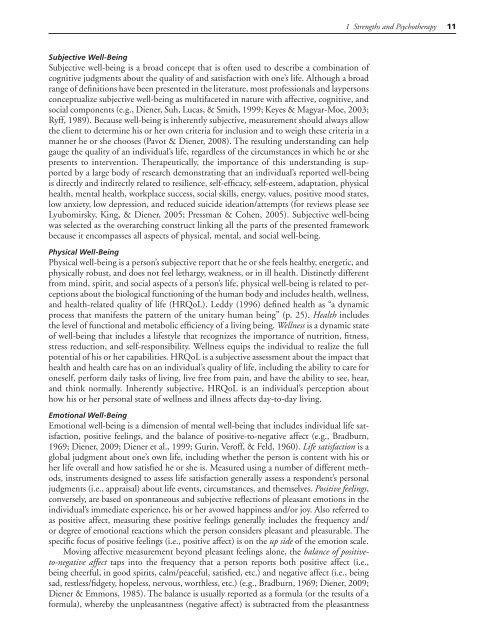Tools for Strengths-Based Assessment and Evaluation - Springer ...
Tools for Strengths-Based Assessment and Evaluation - Springer ...
Tools for Strengths-Based Assessment and Evaluation - Springer ...
Create successful ePaper yourself
Turn your PDF publications into a flip-book with our unique Google optimized e-Paper software.
1 <strong>Strengths</strong> <strong>and</strong> Psychotherapy 11<br />
Subjective Well-Being<br />
Subjective well-being is a broad concept that is often used to describe a combination of<br />
cognitive judgments about the quality of <strong>and</strong> satisfaction with one’s life. Although a broad<br />
range of definitions have been presented in the literature, most professionals <strong>and</strong> laypersons<br />
conceptualize subjective well-being as multifaceted in nature with affective, cognitive, <strong>and</strong><br />
social components (e.g., Diener, Suh, Lucas, & Smith, 1999; Keyes & Magyar-Moe, 2003;<br />
Ryff, 1989). Because well-being is inherently subjective, measurement should always allow<br />
the client to determine his or her own criteria <strong>for</strong> inclusion <strong>and</strong> to weigh these criteria in a<br />
manner he or she chooses (Pavot & Diener, 2008). The resulting underst<strong>and</strong>ing can help<br />
gauge the quality of an individual’s life, regardless of the circumstances in which he or she<br />
presents to intervention. Therapeutically, the importance of this underst<strong>and</strong>ing is supported<br />
by a large body of research demonstrating that an individual’s reported well-being<br />
is directly <strong>and</strong> indirectly related to resilience, self-efficacy, self-esteem, adaptation, physical<br />
health, mental health, workplace success, social skills, energy, values, positive mood states,<br />
low anxiety, low depression, <strong>and</strong> reduced suicide ideation/attempts (<strong>for</strong> reviews please see<br />
Lyubomirsky, King, & Diener, 2005; Pressman & Cohen, 2005). Subjective well-being<br />
was selected as the overarching construct linking all the parts of the presented framework<br />
because it encompasses all aspects of physical, mental, <strong>and</strong> social well-being.<br />
Physical Well-Being<br />
Physical well-being is a person’s subjective report that he or she feels healthy, energetic, <strong>and</strong><br />
physically robust, <strong>and</strong> does not feel lethargy, weakness, or in ill health. Distinctly different<br />
from mind, spirit, <strong>and</strong> social aspects of a person’s life, physical well-being is related to perceptions<br />
about the biological functioning of the human body <strong>and</strong> includes health, wellness,<br />
<strong>and</strong> health-related quality of life (HRQoL). Leddy (1996) defined health as “a dynamic<br />
process that manifests the pattern of the unitary human being” (p. 25). Health includes<br />
the level of functional <strong>and</strong> metabolic efficiency of a living being. Wellness is a dynamic state<br />
of well-being that includes a lifestyle that recognizes the importance of nutrition, fitness,<br />
stress reduction, <strong>and</strong> self-responsibility. Wellness equips the individual to realize the full<br />
potential of his or her capabilities. HRQoL is a subjective assessment about the impact that<br />
health <strong>and</strong> health care has on an individual’s quality of life, including the ability to care <strong>for</strong><br />
oneself, per<strong>for</strong>m daily tasks of living, live free from pain, <strong>and</strong> have the ability to see, hear,<br />
<strong>and</strong> think normally. Inherently subjective, HRQoL is an individual’s perception about<br />
how his or her personal state of wellness <strong>and</strong> illness affects day-to-day living.<br />
Emotional Well-Being<br />
Emotional well-being is a dimension of mental well-being that includes individual life satisfaction,<br />
positive feelings, <strong>and</strong> the balance of positive-to-negative affect (e.g., Bradburn,<br />
1969; Diener, 2009; Diener et al., 1999; Gurin, Veroff, & Feld, 1960). Life satisfaction is a<br />
global judgment about one’s own life, including whether the person is content with his or<br />
her life overall <strong>and</strong> how satisfied he or she is. Measured using a number of different methods,<br />
instruments designed to assess life satisfaction generally assess a respondent’s personal<br />
judgments (i.e., appraisal) about life events, circumstances, <strong>and</strong> themselves. Positive feelings,<br />
conversely, are based on spontaneous <strong>and</strong> subjective reflections of pleasant emotions in the<br />
individual’s immediate experience, his or her avowed happiness <strong>and</strong>/or joy. Also referred to<br />
as positive affect, measuring these positive feelings generally includes the frequency <strong>and</strong>/<br />
or degree of emotional reactions which the person considers pleasant <strong>and</strong> pleasurable. The<br />
specific focus of positive feelings (i.e., positive affect) is on the up side of the emotion scale.<br />
Moving affective measurement beyond pleasant feelings alone, the balance of positiveto-negative<br />
affect taps into the frequency that a person reports both positive affect (i.e.,<br />
being cheerful, in good spirits, calm/peaceful, satisfied, etc.) <strong>and</strong> negative affect (i.e., being<br />
sad, restless/fidgety, hopeless, nervous, worthless, etc.) (e.g., Bradburn, 1969; Diener, 2009;<br />
Diener & Emmons, 1985). The balance is usually reported as a <strong>for</strong>mula (or the results of a<br />
<strong>for</strong>mula), whereby the unpleasantness (negative affect) is subtracted from the pleasantness

















